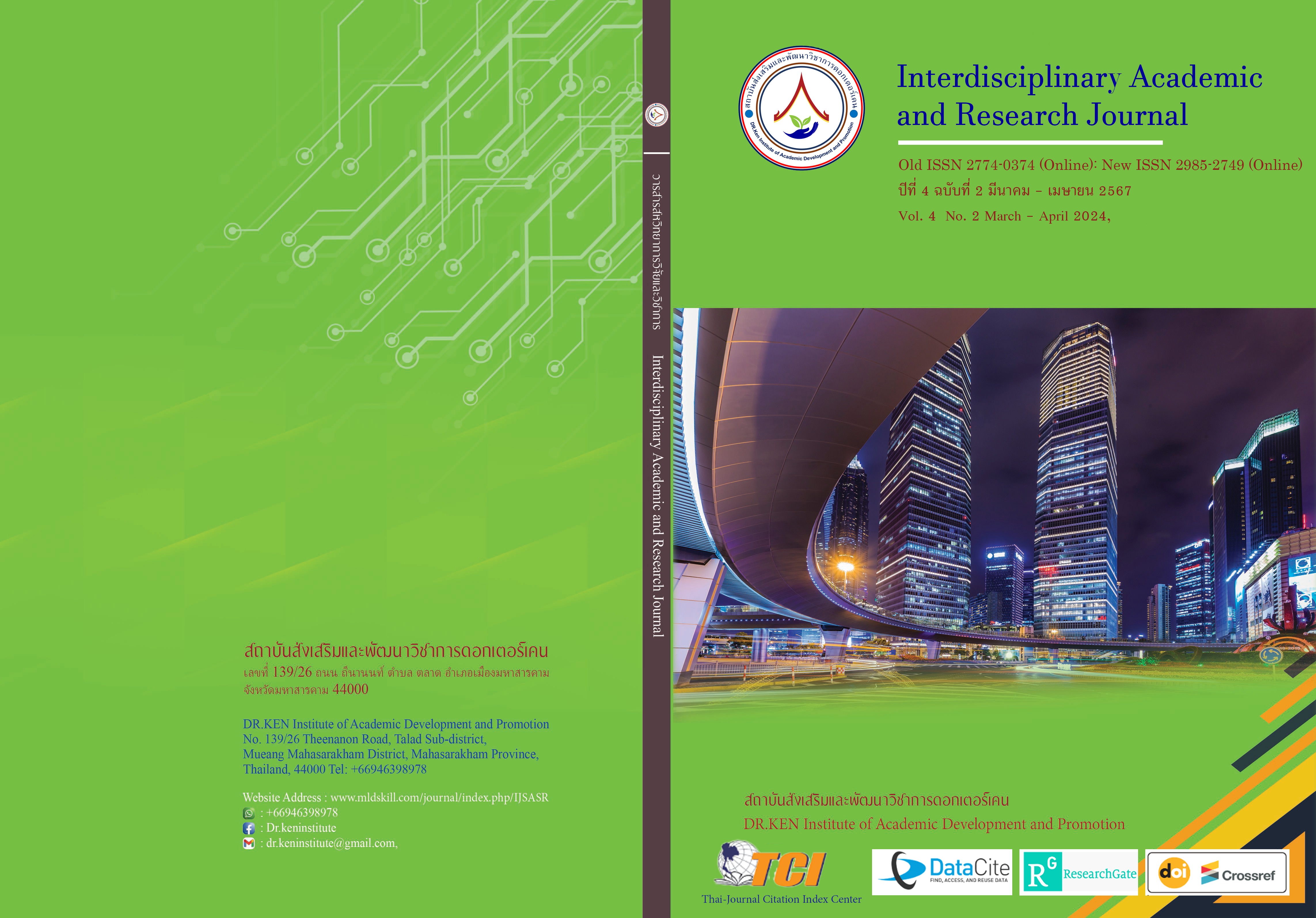The Effects of Feedback on The Ability to Mathematic Problem Solving on Linear Inequality of One Variable for Ninth Grade Students: Application of Frey and Fisher Model
DOI:
https://doi.org/10.60027/iarj.2024.274639Keywords:
Feedback;, Frey and Fisher's Model;, Mathematical Problem-solving AbilityAbstract
Background and Aims: Mathematical problem-solving is an important skill in learning management in mathematics. Teachers should train students to develop their ability to solve mathematical problems regularly. As well as allowing students to solve math problems by themselves to know the shortcomings that need improvement. Including providing feedback and reflection on learning outcomes to students. Consequently, the purpose of this research was to compare students' mathematical problem-solving abilities before and after receiving feedback using Frey and Fisher's model.
Methodology: The research sample group was the grade 9 students from Chitjaichuen school in the first semester of the academic year 2023, a total of 29 students from cluster random sampling. The research instrument used consisted of (1)3 Frey and Fisher's model learning management plans, which each learning management plan has the highest level of appropriateness (2) 3 Problem-solving work sheets with reliability values of 0.791, 0.903, and 0.864, respectively. Difficulty values were in the range of 0.240 - 0.604 and discriminatory power values were in the range of 0.438 - 0.750 and (3) Problem-solving ability test on the Linear Inequality of One Variable. There were 2 versions with reliability values of 0.916, and 0.788, respectively. Difficulty values were in the range of 0.366 – 0.625 and discriminatory power values were in the range of 0.411 – 0.833. The data analysis statistics were frequency, percentage, mean, standard deviation, and dependent sample t-test.
Results: The mathematical problem-solving ability of students by providing feedback using Frey and Fisher's model after learning was significantly higher than before learning at the .05 level. (t = 13.877, p = .000)
Conclusion: Results indicated that students' mathematical problem-solving skills showed significant and statistically significant improvements. When they received feedback using Frey and Fisher's model after engaging in learning activities. It is seen that this improvement is not likely due to chance. It provides clear evidence of the effectiveness of feedback approaches in increasing mathematical problem-solving abilities.
References
กติกร กมลรัตนะสมบัติ. (2558). ผลของการให้ข้อมูลย้อนกลับจากแบบสอบอัตนัยประยุกต์ที่มีต่อพัฒนาการความสามารถในการแก้ปัญหาทางคณิตศาสตร์ของนักเรียนระดับมัธยมศึกษา. วิทยานิพนธ์ปริญญามหาบัณฑิต: จุฬาลงกรณ์มหาวิทยาลัย.
กลุ่มงานนโยบายและแผนงานโรงเรียนชิตใจชื่น. (2566). แผนปฏิบัติการประจำปี 2566. ปราจีนบุรี: โรงเรียนชิตใจชื่น.
กลุ่มงานประกันคุณภาพการศึกษาโรงเรียนชิตใจชื่น. (2565). รายงานการประเมินตนเองของสถานศึกษา ประจำปีการศึกษา 2565.ปราจีนบุรี: โรงเรียนชิตใจชื่น.
กลุ่มสาระการเรียนรู้คณิตศาสตร์ โรงเรียนชิตใจชื่น. (2565). รายงานผลสัมฤทธิ์ทางการเรียนวิชาคณิตศาสตร์ ระดับชั้นมัธยมศึกษาปีที่ 3.ปราจีนบุรี: โรงเรียนชิตใจชื่น.
กิตติทัศน์ หวานฉ่ำ. (2560). ผลของประเภทข้อมูลย้อนกลับและการเปลี่ยนคำตอบที่มีต่อผลสัมฤทธิ์ทางการเรียน คะแนนที่เพิ่มขึ้น และความสามารถในการแก้โจทย์ปัญหาฟิสิกส์ของนักเรียนชั้นมัธยมศึกษาปีที่ 4. วิทยานิพนธ์ปริญญามหาบัณฑิต: จุฬาลงกรณ์มหาวิทยาลัย.
คณาธิป นรสิงห์. (2564). กระบวนการสร้างตัวแบบทางคณิตศาสตร์กับการพัฒนาความสามารถในการแก้ปัญหาทางคณิตศาสตร์ของนักเรียนระดับมัธยมศึกษา. วิทยานิพนธ์ปริญญามหาบัณฑิต: จุฬาลงกรณ์มหาวิทยาลัย.
ชนกพร ฟักสังข์. (2563). การพัฒนาทักษะการเขียน โดยเทคนิคการให้ข้อมูลย้อนกลับสำหรับนักเรียนมัธยมศึกษาปีที่ 5. วารสารศึกษาศาสตร์ มหาวิทยาลัยศิลปากร. 18(2), 110-122. https://so02.tci-thaijo.org/index.php/suedujournal/article/view/247250/167350
ณัฐพร นวนสาย. (2559). การพัฒนาทักษะกระบวนการแก้ปัญหาทางคณิตศาสตร์โดยใช้กระบวนการแก้ปัญหาของโพลยาสำหรับนักเรียนชั้นมัธยมศึกษาปีที่ 3. การประชุมวิชาการเสนอผลงานวิจัยระดับบัณฑิตศึกษาแห่งชาติ พ.ศ. 2560, วันที่ 18 มีนาคม 2561. มหาวิทยาลัยราชภัฏบุรีรัมย์.
ทิวทัศน์ ชัชวาลย์. (2562). การพัฒนาความสามารถในการแก้ปัญหาและการให้เหตุผลทางคณิตศาสตร์เรื่อง บทประยุกต์ ของนักเรียนชั้นประถมศึกษาปีที่ 6 โดยใช้กระบวนการแก้ปัญหา DAPIC ร่วมกับเทคนิคการใช้คำถามของบาดแฮม. วิทยานิพนธ์ปริญญามหาบัณฑิต: มหาวิทยาลัยราชภัฏนครราชสีมา.
บุญชม ศรีสะอาด. (2541). วิธีการทางสถิติสำหรับการวิจัย เล่ม 1. พิมพ์ครั้งที่ 2. สุวีริยะสาส์น
พงศ์พล จินตนประเสริฐ. (2564). การประเมินตนเองโดยใช้รูบริกที่มีวิธีการต่างกันที่มีต่อพัฒนาการทักษะการแก้โจทย์ปัญหาคณิตศาสตร์: วิธีแอนโนเทตประยุกต์และดับเบิ้ลเลเยอร์. วิทยานิพนธ์ปริญญามหาบัณฑิต: จุฬาลงกรณ์มหาวิทยาลัย.
วรกมล บุญรักษา. (2561). การจัดกิจกรรมการเรียนรู้แบบร่วมมือเทคนิคการแบ่งกลุ่มผลสัมฤทธิ์ (STAD) ร่วมกับแนวคิด DAPIC ที่มีต่อความสามารถในการแก้ปัญหาและผลสัมฤทธิ์ทางการเรียนคณิตศาสตร์ เรื่อง ทฤษฎีบทพีทาโกรัส สำหรับนักเรียนชั้นมัธยมศึกษาปีที่ 2. วารสารมนุษยศาสตร์และสังคมศาสตร์ มหาวิทยาลัยราชภัฏสุรินทร์, 20(1), 15-27. https://so03.tci-thaijo.org/index.php/jhssrru/article/view/133353/99987
วิมลพันธ์ ทรายทอง. (2561). การศึกษาความสามารถในการแก้ปัญหาทางคณิตศาสตร์และความยึดมั่นผูกพันในการเรียนของนักเรียนชั้นมัธยมศึกษาปีที่ 5 ที่ได้รับการจัดการเรียนรู้โดยการสอนแนะให้รู้คิดร่วมกับการให้ข้อมูลย้อนกลับเพื่อส่งเสริมการเรียนรู้. วิทยานิพนธ์ปริญญามหาบัณฑิต: มหาวิทยาลัยศรีนครินทรวิโรฒ.
วิไลวรรณ สุระวนิชกุล. (2562). การพัฒนาความสามารถในการแก้ปัญหาทางคณิตศาสตร์โดยใช้การจัดกิจกรรมการเรียนรู้ตามแนวคิดโพลยา ของนักเรียนชั้นมัธยมศึกษาปีที่ 4. วิทยานิพนธ์ปริญญามหาบัณฑิต:มหาวิทยาลัยมหาสารคาม.
ศิริชัย กาญจนวาสี. (2556). สถิติประยุกต์สำหรับการวิจัย. พิมพครั้งที่ 6. กรุงเทพฯ : สำนักพิมพ์แห่งจุฬาลงกรณ์มหาวิทยาลัย.
สง่า วงค์ไชย. (2564). การพัฒนาคุณภาพงานเขียนโดยการให้ข้อมูลย้อนกลับ: กรณีศึกษาแบบทดสอบอัตนัยระดับชาติ. วารสารบัณฑิตศึกษา, 18(80), 1-14. https://so02.tci-thaijo.org/index.php/SNGSJ/article/view/224488/167696
สถาบันส่งเสริมการสอนวิทยาศาสตร์และเทคโนโลยี. (2560). คู่มือการใช้หลักสูตรกลุ่มสาระการเรียนรู้คณิตศาสตร์(ฉบับปรับปรุง พ.ศ. 2560). โรงพิมพ์ชุมนุมสหกรณ์การเกษตรแห่งประเทศไทย จำกัด.
สำนักวิชาการและมาตรฐานการศึกษา. (2560). การประเมินเพื่อการเรียนรู้: การตั้งคำถามและการให้ข้อมูลย้อนกลับเพื่อส่งเสริมการเรียนรู้. โรงพิมพ์ชุมนุมสหกรณ์การเกษตรแห่งประเทศไทย จำกัด.
สุคนธ์ สินธพานนท์. (2552). นวัตกรรมการเรียนการสอนเพื่อพัฒนาคุณภาพของเยาวชน. พิมพ์ครั้งที่ 3. สำนักพิมพ์แห่งจุฬาลงกรณ์มหาวิทยาลัย.
สุสิริยา ธิรากุลนันท์ชัย. (2562). ผลของการจัดกิจกรรมการเรียนรู้คณิตศาสตร์โดยใช้วงจรการเรียนรู้แบบ 7E ร่วมกับการใช้คำถามระดับสูงที่มีต่อความสามารถในการแก้ปัญหาทางคณิตศาสตร์ของนักเรียนมัธยมศึกษาปีที่ 1. วิทยานิพนธ์ปริญญามหาบัณฑิต: จุฬาลงกรณ์มหาวิทยาลัย.
อนงค์ เมธีพิทักษ์ธรรม. (2555). ผลของรูปแบบการให้ข้อมูลย้อนกลับที่แตกต่างกันที่มีต่อความสามารถในการแก้ไขปัญหาทางคณิตศาสตร์ของผู้เรียนระดับมัธยมศึกษาปีที่ 1. วิทยานิพนธ์ปริญญามหาบัณฑิต: จุฬาลงกรณ์มหาวิทยาลัย.
อัมพร ม้าคนอง. (2553). ทักษะกระบวนการทางคณิตศาสตร์: การพัฒนาเพื่อพัฒนาการ. โรงพิมพ์จุฬาลงกรณ์มหาวิทยาลัย.
Attali, Y, & Kleij, F. (2017). Effects of feedback elaboration and feedback timing during computer-based practice in mathematics problem-solving. Computer & Education, 110, 154-169. http://dx.doi.org/10.1016/j.compedu.2017.03.012
Barana, A., Marchisio, M., & Sacchet, M. (2021). Interactive Feedback for Learning Mathematics in a Digital Learning Environment. Education sciences, 11(6), 1-21. https://doi.org/10.3390/educsci11060279
Faul, F., Erdfelder, E., Lang, A.G., & Buchner, A. (2007). G*Power 3: A flexible statistical power analysis program for the social, behavioral, and biomedical sciences. Behavior Research Methods, 39(2), 175-191.
Frey, N., & Fisher, D. (2011). The formative assessment action plan. Alexandria, VA: ASCD.
Hattie, J., & Timperley, H. (2007). The Power of Feedback. Review of Educational Research, 77(1), 81-112. https://doi.org/10.3102/003465430298487
Isaacs, T., Zara, C., Herbert, G., Coombs, S. J. and Smith, C. (2013). Key Concepts in Educational Assessment. London: SAGE Publications Ltd.
kulKrulik, S. & Rudnick, J.A. (1987). Problem Solving. A Handbook for Teachers. 2nd ed., Allyn and Bacon.
Mailisman, N., Ikhsan, M., & Hajidin. (2020). Mathematics problem-solving skills of vocational high school students related to the 21st-century education. Journal of Physics: Conference Series, 1460(1), 1-8. https://doi.org/10.1088/1742-6596/1460/1/012014
Narciss, S., & Huth, K. (2002). How to design informative tutoring feedback for multimedia learning. Retrieved from: https://www.researchgate.net/publication/228749053
Polya, G. (1957). How to Solve It. A New Aspect of Mathematical Method. 2nd Edition, Princeton University Press, Princeton.
Springer, L.M. (2021). Exploring Student Feedback Perceptions and Motivations: A Qualitative Descriptive Study. Doctoral dissertation: Grand Canyon University.
Strozier, T.D. (2022). Exploring Culturally Relevant Feedback to African American Students in Mathematics. Doctoral dissertation: Grand Canyon University.
Downloads
Published
How to Cite
Issue
Section
License
Copyright (c) 2024 Interdisciplinary Academic and Research Journal

This work is licensed under a Creative Commons Attribution-NonCommercial-NoDerivatives 4.0 International License.
Copyright on any article in the Interdisciplinary Academic and Research Journal is retained by the author(s) under the under the Creative Commons Attribution-NonCommercial-NoDerivatives 4.0 International License. Permission to use text, content, images, etc. of publication. Any user to read, download, copy, distribute, print, search, or link to the full texts of articles, crawl them for indexing, pass them as data to software, or use them for any other lawful purpose. But do not use it for commercial use or with the intent to benefit any business.
















.png)


